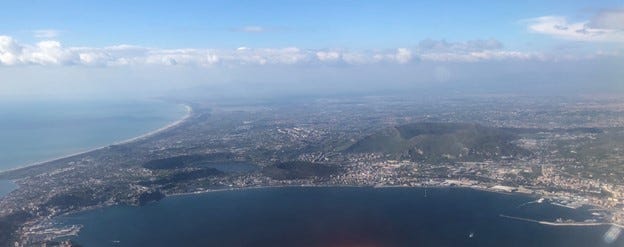The well-known volcano Vesuvius lies to the east of Naples, but a further tectonic complication for Naples is that to the west of the city is the Campi Flegrei (Phlegraean fields) [Figure 1]. Here there are other forms of volcanic activity, including solfataras (sulphur springs – note the term ‘solfatara’ originated from here) and hot mudbaths. In classical times, both Homer and Virgil wrote that this area marked the entrance to Hades (or Hell). Later, however, it became famed for its health-cure properties.
Figure 1. Tectonic activity in the Naples region
A new study by University College London has warned that this area, with its sub-surface ‘supervolcano’ which hasn’t erupted since 1538, is getting closer to a potential eruption, and the consequences could be catastrophic. More than 1.5 million people live above the vast underground supervolcano complex, and half a million people have their homes inside its 11 kilometres wide caldera system, which was formed after an enormous eruption 39,000 years ago.
At its most extreme, if Campi Flegrei were to reenact its largest previous eruption, it would punch molten rock and volcanic gases high into the stratosphere, unleash tsunami up to 30m high and spread a plume of sulphur and toxic ash that could plunge the planet into a global winter for years - killing crops and causing mass extinctions.
The volcanic area has been stirring since the mid-20th century, with bursts of heightened activity in the 1950s, 1970s and 1980s. Another period of unrest began in the last decade and is still ongoing, during which the ground below Pozzuoli has risen by 10 centimetres each year, adding up to a total change in elevation of 4m since the 1950s. Campi Flegrei is also experiencing persistent small earthquakes, with more than 600 detected in April 2023 - breaking its largest monthly total ever recorded in the region.
The subterranean movement is being driven by volcanic gas seeping into the crust 3 km beneath Campi Flegrei's surface, ‘which soaks it up like a sponge’, the researchers said. This causes the crust to stretch, warp and slip, sending earthquakes to the surface. If enough volcanic gas enters the crust, the heat and pressure it provides can push the rocks beyond ‘critical degassing pressure’ rupturing them and opening a crack for the magma beneath to burst outwards in an eruption.
This means that even though the earthquakes in the region are not as powerful as they were in the 1980s, the weaker rock has the potential to rupture under smaller strains, giving seismologists fewer detectable earthquakes and people less notice to evacuate. Despite this, the UCL scientists say this doesn't mean a gigantic eruption is now inevitable. For volcanoes to blow, gases must build up faster than they can escape, and magma also needs to be able to move rapidly through the crust where a crack has formed - two conditions that are difficult to measure.
‘It's the same for all volcanoes that have been quiet for generations. Campi Flegrei may settle into a new routine of gently rising and subsiding, as seen at similar volcanoes around the world, or simply return to rest,’ Stefano Carlino, a researcher at the Vesuvius Observatory, said. ‘We can't yet say for sure what will happen. The important point is to be prepared for all outcomes.’
Satellite image (2016)
Photo: NASA
Aerial photograph of Campi Flegrei






